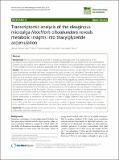Transcriptomic analysis of the oleaginous microalga Neochloris oleoabundans reveals metabolic insights into triacylglyceride accumulation
Author(s)
Rismani-Yazdi, Hamid; Haznedaroglu, Berat Z.; Hsin, Carol; Peccia, Jordan
Download1754-6834-5-74.pdf (1.845Mb)
PUBLISHER_CC
Publisher with Creative Commons License
Creative Commons Attribution
Terms of use
Metadata
Show full item recordAbstract
Background:
The lack of sequenced genomes for oleaginous microalgae limits our understanding of the mechanisms these organisms utilize to become enriched in triglycerides. Here we report the de novo transcriptome assembly and quantitative gene expression analysis of the oleaginous microalga Neochloris oleoabundans, with a focus on the complex interaction of pathways associated with the production of the triacylglycerol (TAG) biofuel precursor.
Results:
After growth under nitrogen replete and nitrogen limiting conditions, we quantified the cellular content of major biomolecules including total lipids, triacylglycerides, starch, protein, and chlorophyll. Transcribed genes were sequenced, the transcriptome was assembled de novo, and the expression of major functional categories, relevant pathways, and important genes was quantified through the mapping of reads to the transcriptome. Over 87 million, 77 base pair high quality reads were produced on the Illumina HiSeq sequencing platform. Metabolite measurements supported by genes and pathway expression results indicated that under the nitrogen-limiting condition, carbon is partitioned toward triglyceride production, which increased fivefold over the nitrogen-replete control. In addition to the observed overexpression of the fatty acid synthesis pathway, TAG production during nitrogen limitation was bolstered by repression of the β-oxidation pathway, up-regulation of genes encoding for the pyruvate dehydrogenase complex which funnels acetyl-CoA to lipid biosynthesis, activation of the pentose phosphate pathway to supply reducing equivalents to inorganic nitrogen assimilation and fatty acid biosynthesis, and the up-regulation of lipases—presumably to reconstruct cell membranes in order to supply additional fatty acids for TAG biosynthesis.
Conclusions:
Our quantitative transcriptome study reveals a broad overview of how nitrogen stress results in excess TAG production in N. oleoabundans, and provides a variety of genetic engineering targets and strategies for focused efforts to improve the production rate and cellular content of biofuel precursors in oleaginous microalgae.
Date issued
2012-09Department
Massachusetts Institute of Technology. Department of Chemical EngineeringJournal
Biotechnology for Biofuels
Publisher
BioMed Central Ltd.
Citation
Rismani-Yazdi, Hamid et al. “Transcriptomic Analysis of the Oleaginous Microalga Neochloris Oleoabundans Reveals Metabolic Insights into Triacylglyceride Accumulation.” Biotechnology for Biofuels 5.1 (2012): 74. Web.
Version: Final published version
ISSN
1754-6834